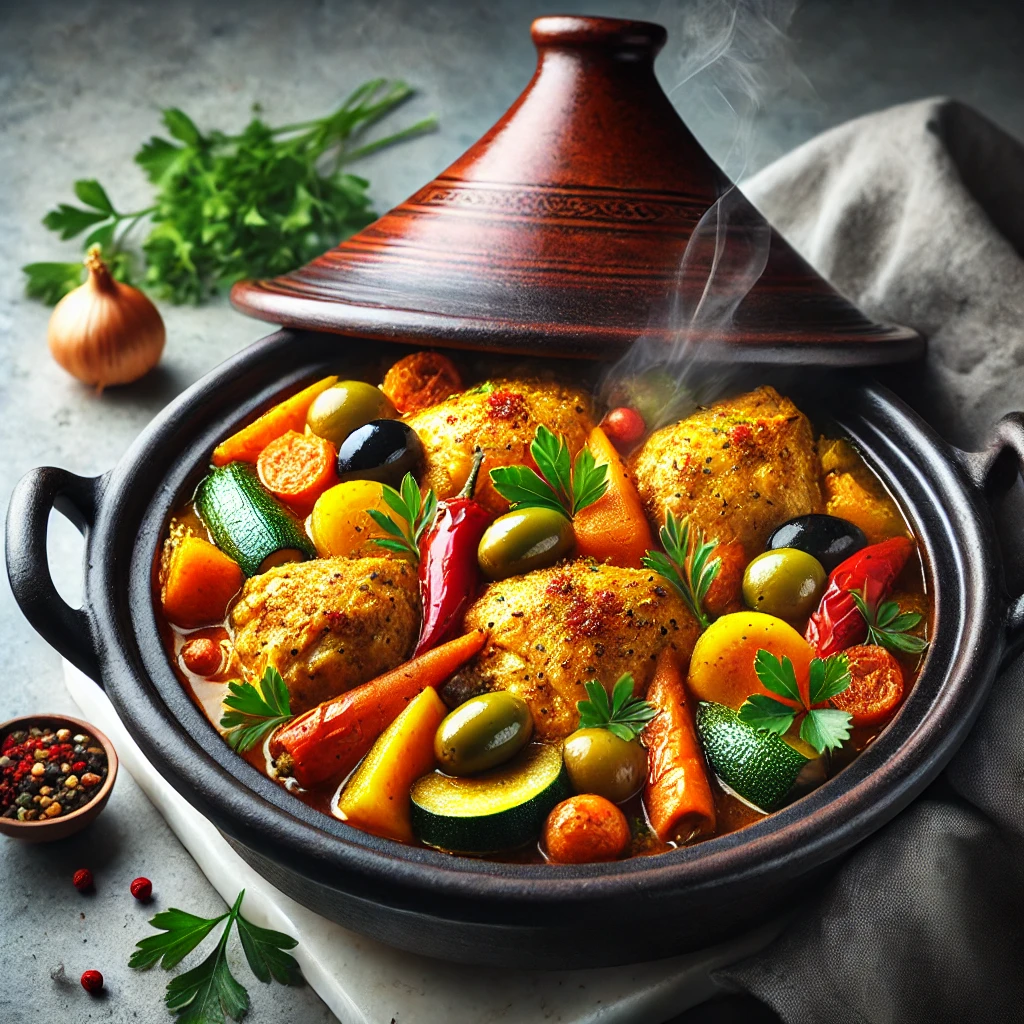The Best Moroccan Chicken Tagine Ideas for Every Occasion
Introduction
Craving something warm, aromatic, and packed with flavor? 🍋🍗 Moroccan chicken tagine is the perfect one-pot dish that brings together tender chicken, vibrant spices, and slow-cooked goodness in every bite. Whether you’re cooking for a cozy weeknight dinner or a festive family gathering, there’s a tagine recipe to match the moment. In this post, we’ll explore the best Moroccan chicken tagine ideas for every occasion—using traditional ingredients like preserved lemon, olives, and classic North African spices—to help you create a meal that’s as impressive as it is comforting.
1. What Makes Moroccan Chicken Tagine So Special?
Moroccan chicken tagine isn’t just a dish—it’s a sensory experience that tells a story of rich traditions and bold flavors. What sets it apart is the unique combination of slow-cooked tenderness, warm spices like cumin and turmeric, and the unmistakable aroma of preserved lemon and olives. Cooked in a traditional conical clay pot, tagine brings out deep, layered flavors that make every bite unforgettable. Let’s dive into what makes this iconic Moroccan meal truly special.
The origins of Moroccan tagine cooking
The origins of Moroccan tagine cooking trace back centuries, deeply rooted in the culinary traditions of North Africa and shaped by the diverse cultures that have influenced Morocco over time—including Berber, Arab, Andalusian, and French. The word tagine refers to both the iconic conical clay pot and the dish itself, which is known for its slow-cooked, layered flavors. Originally used by Berber nomads, the tagine was a practical way to cook hearty, flavorful meals over open fires, using minimal resources. Its unique shape helps circulate steam and retain moisture, making it ideal for tenderizing meats and infusing vegetables with aromatic spices. Over generations, Moroccan families have passed down their own versions of tagine recipes, each one a reflection of regional ingredients, spice blends, and family traditions. Today, the tagine remains a symbol of Moroccan hospitality, comfort, and the art of slow, soulful cooking.
Signature spices: cumin, turmeric, paprika, saffron
The magic of Moroccan chicken tagine lies in its carefully layered spices, each adding depth, color, and aroma to the dish. Cumin brings a warm, earthy undertone that enhances the savory profile of the chicken. Turmeric adds a gentle bitterness and a beautiful golden hue, giving the dish its signature warm color. Paprika, whether sweet or smoky, contributes a mild heat and rich flavor that balances perfectly with the other spices. And of course, saffron—one of the most treasured spices in Moroccan cuisine—adds a subtle floral note and a luxurious depth that elevates the entire tagine. When combined, these spices create a complex and comforting flavor base that defines the heart of Moroccan cooking.
Cooking method: slow-cooked flavors in a tagine pot
One of the most defining features of a Moroccan chicken tagine is its slow-cooking method, traditionally done in a tagine pot—a conical clay vessel designed to trap steam and circulate moisture. This unique shape allows the ingredients to gently simmer and baste themselves, locking in flavor and creating incredibly tender chicken with minimal effort. As the dish cooks slowly over low heat, the spices bloom, the meat absorbs the fragrant sauce, and the vegetables become meltingly soft. The result? A rich, deeply flavorful stew that requires little stirring but delivers big on taste. Whether you’re using a traditional clay tagine over a flame or a modern Dutch oven on your stovetop, the slow-cooked approach is key to achieving that authentic Moroccan depth and warmth. 🏺🔥
The role of preserved lemon and green olives
Preserved lemon and green olives are two of the most iconic ingredients in a traditional Moroccan chicken tagine, and their role goes far beyond simple garnish. 🌿✨
Preserved lemon brings a deep, complex citrus flavor that’s both tangy and slightly fermented—completely different from fresh lemon. It adds a bold brightness that cuts through the richness of the slow-cooked chicken and spices, lifting the entire dish with a zesty punch. Just a few wedges can transform the broth into something irresistibly aromatic and full of depth.
Green olives, on the other hand, contribute a briny, slightly bitter contrast that balances the sweetness of caramelized onions and roasted vegetables often found in the dish. Their firm texture holds up beautifully in the slow cooking process, adding little bursts of flavor in every bite.
Together, these ingredients create the signature taste that makes Moroccan chicken tagine unforgettable—earthy, citrusy, savory, and perfectly balanced. 🍋🫒🔥
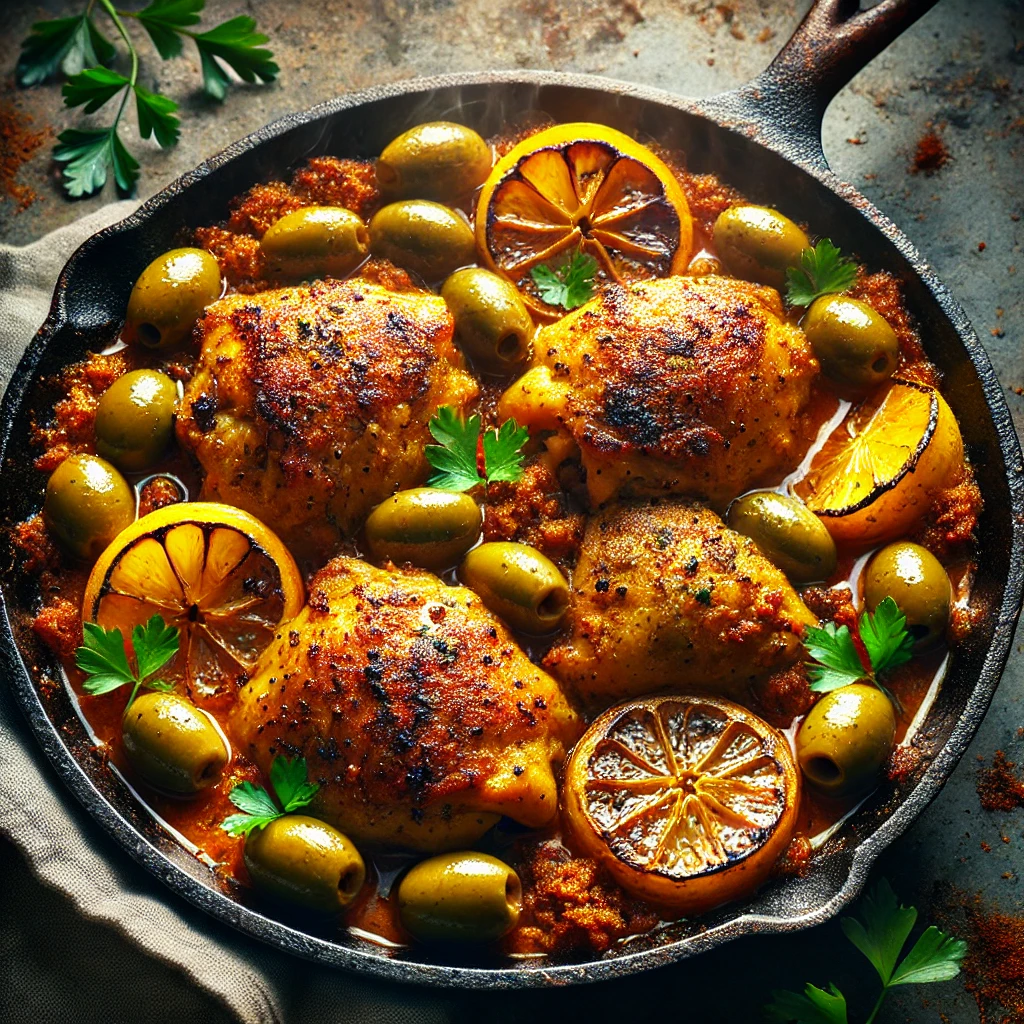
2. Essential Ingredients for an Authentic Chicken Tagine
Creating a truly authentic Moroccan chicken tagine starts with the right ingredients—each one bringing depth, aroma, and tradition to the dish. From richly spiced chicken to vibrant vegetables and signature touches like preserved lemon and olives, every component plays a key role in building those bold, comforting flavors. Let’s take a closer look at the must-have ingredients that make a chicken tagine unmistakably Moroccan. 🍗🍋🌿
Best cuts of chicken: thighs vs drumsticks
When it comes to making an authentic and flavorful chicken tagine, the cut of chicken you choose can make a big difference in both taste and texture. 🍗
Chicken thighs are often the top choice for Moroccan tagines. Their higher fat content and dark meat make them incredibly juicy, rich, and flavorful—perfect for slow cooking. Thighs hold up well during long simmering times, absorbing the spices and aromatics without drying out. Bone-in, skin-on thighs also contribute to a deeper, more savory broth, especially when seared before braising.
Drumsticks are another great option, offering similar benefits to thighs with slightly more connective tissue, which breaks down beautifully during cooking to create that fall-off-the-bone tenderness. They also add visual variety to the dish and are often a favorite at the table thanks to their handheld appeal.
While some recipes use whole chickens or breast meat, dark meat cuts like thighs and drumsticks are ideal for capturing the full essence of a traditional Moroccan tagine. They’re forgiving, full of flavor, and bring that satisfying, melt-in-your-mouth texture that makes this dish so comforting and communal.
Key aromatics: onion, garlic, ginger
No Moroccan chicken tagine would be complete without the trio of essential aromatics: onion, garlic, and ginger. These humble ingredients form the fragrant foundation of the dish, infusing the chicken and broth with layers of deep, warming flavor from the very first sizzle.
Onions are typically sautéed until soft and golden, providing a mellow sweetness that balances the spices. In some traditional recipes, finely chopped onions are almost melted into the sauce, creating a luscious base that carries all the seasoning.
Garlic adds its unmistakable punch, complementing the sweetness of the onions and enhancing the savory character of the dish. Whether thinly sliced or minced, garlic releases its full aroma when gently cooked in oil, becoming rich and mellow.
Fresh ginger, often grated or finely chopped, introduces a subtle heat and brightness that lifts the entire dish. It pairs beautifully with Moroccan spices like cumin and turmeric, adding depth without overpowering the other ingredients.
Together, these aromatics create a savory-sweet backbone that sets the stage for the rest of the tagine to shine. Their fragrance alone is enough to make your kitchen smell like a spice market in Marrakech!
Spice blend essentials for depth and warmth
The heart of every Moroccan chicken tagine lies in its spice blend—a fragrant, earthy mix that transforms simple ingredients into something deeply flavorful and soul-warming. 🇲🇦✨ These spices aren’t necessarily hot, but they add layers of warmth, complexity, and aroma that define Moroccan cuisine.
Cumin brings a nutty, slightly smoky base that anchors the dish, while paprika adds a subtle sweetness and vibrant red hue. Turmeric not only gives the chicken its beautiful golden color but also adds a gentle bitterness that balances the overall flavor. Ginger and cinnamon provide delicate warmth and a hint of sweetness, while a touch of black pepper adds a subtle kick.
Some cooks also include ras el hanout, a traditional Moroccan spice blend made from up to 30 spices, including cardamom, coriander, allspice, and cloves. It’s the ultimate shortcut to achieving that signature North African flavor profile.
When these spices are combined and gently simmered with the chicken, they infuse the dish with depth, fragrance, and a comforting richness that makes every bite unforgettable
Optional add-ins: dried fruits, chickpeas, or almonds
While a classic Moroccan chicken tagine is already full of bold flavor, optional add-ins like dried fruits, chickpeas, and toasted almonds can elevate the dish to a whole new level of richness, texture, and contrast. 🌟
Dried fruits such as apricots, raisins, or prunes introduce a gentle sweetness that beautifully balances the savory and spiced elements of the tagine. They soften as they cook, soaking up the aromatic sauce and offering bursts of flavor in every bite—especially perfect for festive occasions or special gatherings.
Chickpeas not only add a hearty, plant-based protein, but they also absorb the broth’s spices wonderfully. They make the dish more filling and are ideal for turning your tagine into a wholesome, well-rounded meal.
Toasted almonds, meanwhile, bring an unexpected crunch and nuttiness that complements the tender textures of chicken and vegetables. Sprinkled just before serving, they add a delightful layer of contrast—both in flavor and appearance.
Including these optional ingredients allows you to customize your chicken tagine based on the occasion, the season, or simply your mood, making it as simple or elaborate as you like.
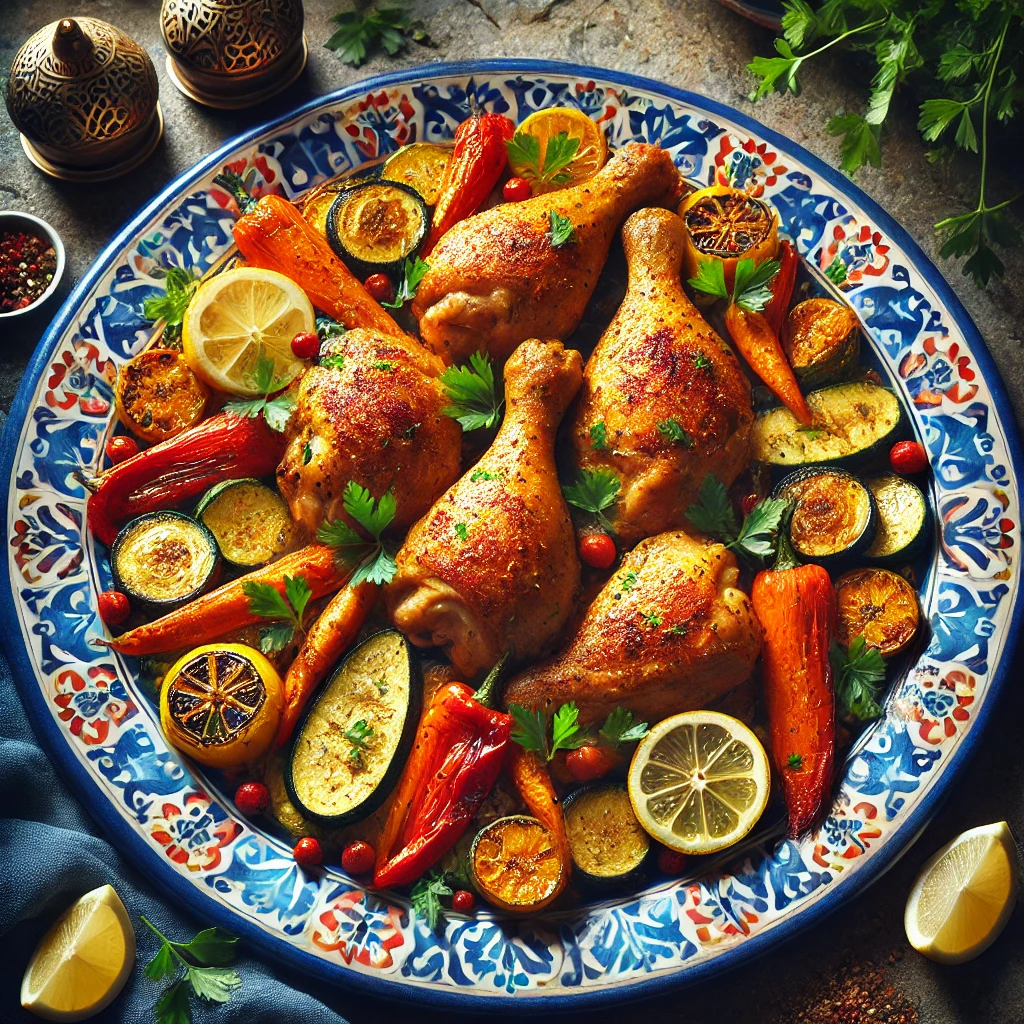
3. Moroccan Chicken Tagine Ideas for Every Occasion
One of the beauties of Moroccan chicken tagine is its versatility—you can tailor it to fit any occasion, from quick weeknight dinners to festive family feasts. With just a few simple adjustments in ingredients or presentation, this traditional dish can feel both comforting and elegant. Whether you’re craving something simple and hearty or looking to impress guests with bold, exotic flavors, there’s a tagine idea here to match the moment. Let’s explore how to make Moroccan chicken tagine shine no matter the setting. 🍗🍋🥘
Weeknight Tagine: quick and easy version with minimal prep
Busy weeknights call for comforting meals that don’t require hours in the kitchen—and that’s where a simplified Moroccan chicken tagine truly shines. This quick and easy version stays true to the dish’s bold North African flavors while cutting down on prep time and cooking steps.
Instead of using a traditional clay tagine, you can cook this variation in a deep skillet or Dutch oven with equally delicious results. Opt for boneless, skinless chicken thighs or drumsticks for faster cooking, and use pre-chopped vegetables like carrots, bell peppers, and zucchini to save time. A simple spice mix of cumin, paprika, turmeric, garlic, and a touch of cinnamon brings warmth and depth to the dish, even in under an hour.
Add a handful of green olives and a few lemon wedges toward the end of cooking for that unmistakable Moroccan flair, and finish with a sprinkle of fresh parsley. Serve with warm couscous or crusty bread, and you’ve got a flavorful, nourishing tagine that fits perfectly into a busy schedule—no tagine pot required!
Festive Tagine: with apricots, almonds, and saffron for special dinners
When it comes to special occasions, a festive Moroccan chicken tagine with apricots, almonds, and saffron brings a touch of elegance and warmth to the table. This luxurious variation blends sweet and savory notes, creating a rich, aromatic dish that feels celebratory with every bite.
Dried apricots simmer alongside the chicken, absorbing the spiced broth and releasing a natural sweetness that pairs beautifully with the dish’s earthy undertones. Toasted almonds add a delightful crunch and nutty depth, offering contrast to the soft textures of the meat and fruit. The addition of saffron, often referred to as culinary gold, infuses the sauce with a delicate floral aroma and a golden hue that instantly elevates the presentation.
Traditionally served at weddings, holidays, or gatherings, this tagine variation is ideal when you want to impress your guests or add a luxurious twist to your meal. Serve it with fluffy couscous, sprinkle with chopped parsley or cilantro, and pair it with mint tea or a citrusy side salad for a truly Moroccan experience. 🍗🌰🍑✨
Family-Style Tagine: big-batch with vegetables and couscous for sharing
When it comes to feeding a crowd or gathering around the table with loved ones, a family-style Moroccan chicken tagine is the perfect centerpiece. This version is all about abundance—generous portions of tender chicken, a colorful medley of vegetables like carrots, zucchini, and bell peppers, and warm Moroccan spices that fill the kitchen with irresistible aroma. Simmered slowly in a large tagine or Dutch oven, the dish becomes deeply flavorful and incredibly satisfying.
What makes it ideal for sharing is not just the quantity, but the communal spirit of Moroccan dining. Serve the tagine directly in its cooking vessel, surrounded by fluffy couscous or warm khobz (Moroccan bread) so everyone can scoop, savor, and enjoy together. A sprinkle of fresh parsley and a few lemon wedges on top add brightness to the earthy spices, creating a well-balanced dish that’s as nourishing as it is comforting.
Whether it’s a weekend gathering, a special celebration, or a cozy Sunday meal, this big-batch tagine brings people together—because in Moroccan cuisine, food is meant to be shared. 🍗🥕
Ramadan or Holiday Tagine: rich, comforting, and slow-cooked for tradition
During Ramadan or special holiday celebrations, Moroccan chicken tagine becomes more than just a meal—it’s a symbol of tradition, togetherness, and spiritual nourishment. This version of the dish is typically richer and more indulgent, often featuring slow-cooked chicken infused with saffron, cinnamon, and ginger for a deep, aromatic flavor profile that feels both festive and comforting.
To elevate the dish for such occasions, home cooks often add dried apricots, prunes, or golden raisins, which simmer down into the sauce, creating a natural sweetness that beautifully balances the spices. Toasted almonds or sesame seeds may be sprinkled over the top just before serving for a delicate crunch and extra elegance.
The result is a tagine that’s warming, flavorful, and full of love—perfect for serving at sunset after a day of fasting or as the centerpiece of a joyful family gathering. Served with fluffy couscous or warm khobz, this holiday-style chicken tagine brings people together in the most delicious way. 🍗🌙🍞
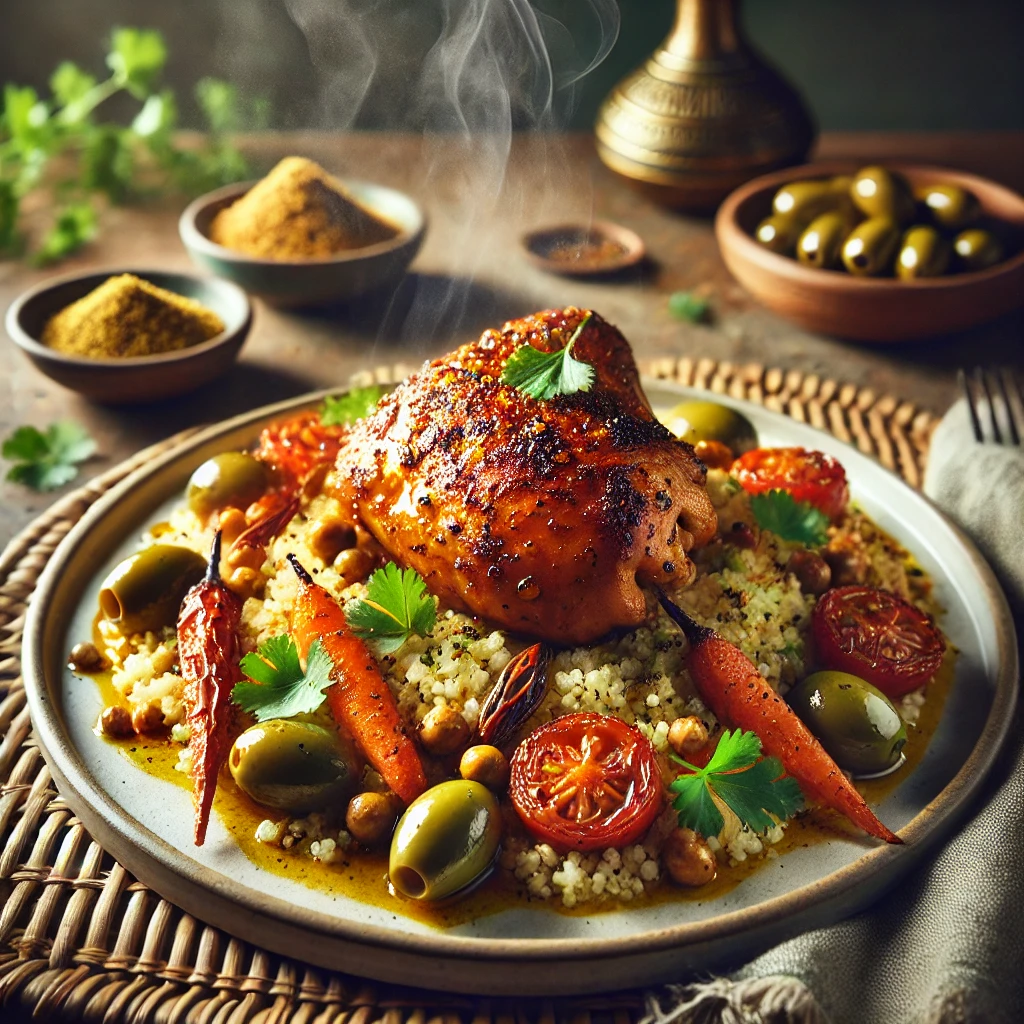
4. How to Cook Chicken Tagine (With or Without a Tagine Pot)
Cooking a Moroccan chicken tagine may sound exotic, but it’s surprisingly approachable—even if you don’t own a traditional tagine pot. While the conical clay tagine offers authentic slow-cooked flavor and presentation, you can still achieve delicious results using a Dutch oven, cast-iron skillet, or even a slow cooker. The key lies in the layering of ingredients, the gentle simmer, and the bold spices that infuse every bite. In this section, we’ll walk you through the basics of making chicken tagine—both the traditional way and convenient alternatives for any kitchen setup. 🍗🔥🍋
Using a traditional clay tagine pot vs Dutch oven
One of the first choices you’ll make when preparing a Moroccan chicken tagine is selecting the right cooking vessel. Both a traditional clay tagine pot and a Dutch oven have their strengths, and each brings a slightly different experience to the table—both in flavor and style. 🍲🔥
🏺 Traditional Clay Tagine Pot:
The classic tagine, with its iconic conical lid, is designed specifically for slow, gentle cooking. The unique shape allows steam to rise, condense, and then drip back down onto the food, keeping everything moist and tender without needing much liquid. This self-basting effect helps intensify the flavors and develop the rich, aromatic sauce that tagines are known for. Traditional tagines are often made of unglazed clay or ceramic, adding a subtle earthy note to the dish.
However, clay tagines require low, gradual heat and are best used on a diffuser if cooking on the stovetop. They’re also ideal for oven cooking and for presentation—bringing the dish straight to the table in its beautiful, rustic pot makes for a stunning, authentic experience.
🍳 Dutch Oven Alternative:
If you don’t have a tagine pot, a Dutch oven is an excellent substitute. Its heavy lid and thick walls mimic the slow, even heat distribution of a tagine, making it perfect for braising. While it doesn’t offer the same steam circulation as the conical lid, it still produces tender, flavorful chicken with a beautifully spiced sauce.
Dutch ovens are also more forgiving, easier to use on all stovetops, and don’t require special care like clay pots do. They’re especially handy for weeknight meals or larger portions when you’re cooking for a crowd.
Whether you go traditional or modern, both options will deliver the warm, comforting flavors of Moroccan chicken tagine—you simply choose the one that fits your cooking style best! 🌿🍗✨
Step-by-step basics: browning, layering, slow simmering
Mastering a Moroccan chicken tagine starts with understanding the rhythm of its cooking process—browning, layering, and slow simmering. Each step builds flavor and texture, turning simple ingredients into a deeply satisfying dish. 🍗✨
1. Browning the Chicken:
Begin by seasoning your chicken thighs or drumsticks with salt, pepper, and your chosen spices—typically a blend of cumin, paprika, turmeric, and ginger. In a hot, oiled tagine base or Dutch oven, sear the chicken pieces skin-side down until they develop a rich, golden crust. This step locks in moisture and adds depth to the final sauce.
2. Layering the Ingredients:
Once the chicken is browned, remove it temporarily and build your flavor base with sliced onions, garlic, and any other aromatics. Then return the chicken to the pot and begin layering vegetables like carrots, zucchini, and bell peppers. Add preserved lemon slices, olives, and dried fruits if using, tucking them around the meat. Pour in just enough broth or water to create steam—tagines rely on moisture retention, not boiling.
3. Slow Simmering:
Cover with a lid (tagine or otherwise) and let the dish gently simmer over low heat. The unique design of the tagine lid allows condensation to drip back down, creating tender meat and a rich, concentrated sauce. Cooking low and slow—usually 1.5 to 2 hours—allows all the ingredients to meld together beautifully, delivering that signature Moroccan warmth and complexity.
This method isn’t just about technique—it’s a celebration of patience, fragrance, and the kind of comfort food meant to be shared. 🍋🫒🧄
Tips for achieving perfectly tender chicken and veggies
One of the hallmarks of a great Moroccan chicken tagine is its melt-in-your-mouth chicken and perfectly tender vegetables—each infused with the rich flavors of the spices and broth. Achieving that ideal texture doesn’t happen by chance; it’s all about technique, timing, and layering.
Here are some essential tips to help you get it just right:
1. Choose the Right Cut of Chicken
Bone-in, skin-on chicken thighs or drumsticks are ideal. They hold up beautifully to long, slow cooking, staying juicy and flavorful while absorbing the spices and sauce.
2. Brown the Chicken First
Before simmering, sear the chicken pieces in your pot or tagine until golden brown. This adds depth of flavor and helps lock in the juices for more tender results.
3. Layer Ingredients Strategically
Place onions and garlic on the bottom, followed by the chicken, then top with harder vegetables like carrots and potatoes. Softer veggies, such as zucchini or bell peppers, can be added later so they don’t overcook.
4. Low and Slow is Key
Tagines are traditionally cooked over low heat for a long period. This slow simmer allows the chicken to become fall-off-the-bone tender and gives the vegetables time to soak up the rich, spiced broth without turning mushy.
5. Don’t Overcrowd the Pot
Give your ingredients a little breathing room. Overpacking can lead to steaming rather than braising, which might result in unevenly cooked meat and soggy veggies.
6. Add Delicate Ingredients Last
Fresh herbs, olives, preserved lemon, and dried fruits should be added in the final stages of cooking to preserve their texture and flavor.
By following these tips, you’ll ensure every bite of your chicken tagine is tender, flavorful, and irresistibly satisfying—just like it’s meant to be in Moroccan tradition. 🍋🌿🔥
Adapting the recipe for slow cooker or stovetop
Not everyone has access to a traditional tagine pot, but the good news is you can still enjoy all the delicious flavors of Moroccan chicken tagine by adapting the recipe for a slow cooker or stovetop—no tagine required! 🙌🍲
Slow Cooker Method:
Perfect for busy days, the slow cooker brings out the deep, aromatic flavors of tagine with minimal effort. Simply layer your spiced chicken thighs, vegetables, olives, and preserved lemon into the slow cooker, pour in your broth or sauce base, and set it to cook on low for 6–8 hours or high for 3–4 hours. The result is fall-off-the-bone tender chicken with a richly developed sauce—just like the traditional method, but hands-free!
Stovetop Method:
If you’re short on time or prefer more control over the cooking process, the stovetop method is a fantastic option. Use a heavy-bottomed pot or Dutch oven, and begin by browning the chicken to develop flavor. Remove the chicken, then sauté onions, garlic, and spices, before returning the chicken and layering in the vegetables, olives, and lemon. Simmer gently over low heat for about 45–60 minutes, partially covered, until everything is tender and infused with flavor.
Both adaptations are excellent for recreating that signature Moroccan taste—even without the tagine pot. Just remember: low and slow wins the flavor game! 🍗🫒🔥
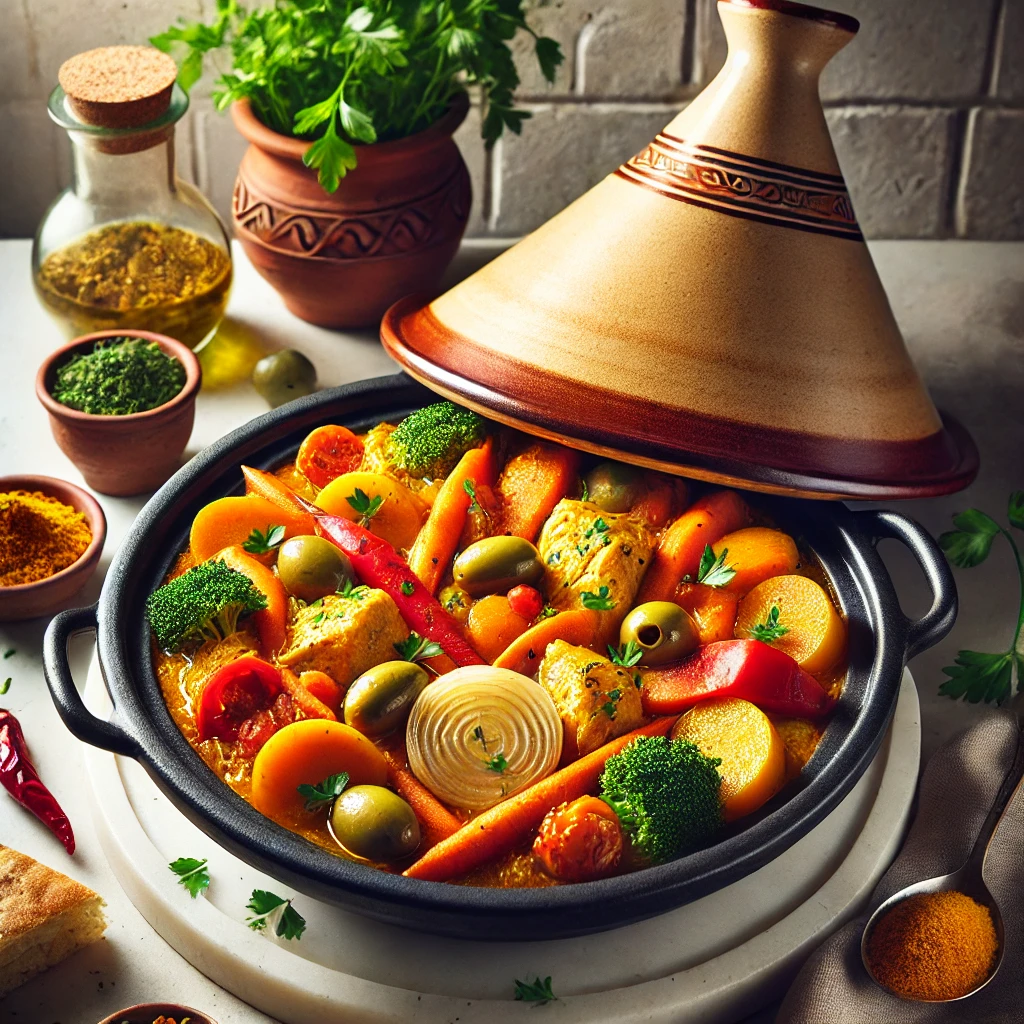
5. What to Serve with Moroccan Chicken Tagine
Moroccan chicken tagine is a flavorful and hearty main dish, but what truly completes the meal are the delicious accompaniments that bring balance, texture, and tradition to the table. Whether you’re aiming for a comforting family dinner or a festive gathering, pairing your tagine with the right sides can enhance the entire experience. From fluffy couscous to freshly baked khobz and refreshing salads, here are the best serving ideas to complement your Moroccan chicken tagine. 🍞🍋🥗
Traditional sides: fluffy couscous or crusty khobz (Moroccan bread)
No Moroccan chicken tagine is complete without the traditional sides that have been served alongside it for generations. Two of the most beloved accompaniments are fluffy couscous and crusty khobz, each offering a different way to soak up the tagine’s aromatic, spice-infused sauce. 🍞🍚
Couscous, a staple in North African cuisine, is made from steamed semolina and has a light, airy texture that pairs beautifully with rich tagine gravies. It absorbs the flavors effortlessly, making every bite tender and satisfying. Often served plain, couscous can also be elevated with a touch of butter, cinnamon, or even golden raisins for a sweeter twist during festive occasions.
On the other hand, khobz, the round, crusty Moroccan flatbread, brings a rustic, hands-on charm to the meal. Baked in clay ovens or home ovens, it’s perfect for scooping up tender chicken and vegetables, or wiping the last drop of sauce from the plate. With its chewy inside and crisp exterior, khobz is both functional and flavorful—no utensils required!
Whether you prefer the delicate grains of couscous or the hearty pull of freshly baked bread, these traditional sides turn Moroccan chicken tagine into a complete, comforting, and communal meal. 🌿🔥
Fresh accompaniments: mint tea, chopped salad, or pickled veggies
To balance the rich, spiced flavors of Moroccan chicken tagine, fresh and vibrant side dishes are essential. They cleanse the palate, enhance the overall dining experience, and add beautiful color and texture to your table. 🌿🍵🥗
Mint tea—often referred to as “Moroccan whiskey”—is more than just a beverage; it’s a ritual. Served hot and sweet, this green tea infused with fresh mint offers a cooling, aromatic contrast to the warmth of the tagine, and helps aid digestion. It’s a traditional way to begin or end a Moroccan meal.
Chopped salads, typically made with cucumbers, tomatoes, red onion, and a splash of lemon juice or olive oil, add a crisp, refreshing bite that complements the slow-cooked, tender chicken. You can also include variations with grated carrots, beets, or even oranges for a sweet-savory twist.
Pickled vegetables, such as carrots, turnips, or preserved lemons, offer a tangy crunch that cuts through the richness of the tagine. Their acidity brightens up each bite and provides a satisfying contrast that keeps the meal balanced and lively.
Together, these accompaniments not only round out the meal but also reflect the hospitality and sensory richness of Moroccan cuisine. 💚🍋🍅
Garnishes: parsley, coriander, or a spoonful of harissa
The finishing touches on a Moroccan chicken tagine are just as important as the main ingredients—they add color, brightness, and that final layer of flavor that ties everything together. 🌿✨
Fresh parsley is a classic choice, offering a clean, herbaceous note that contrasts beautifully with the warm spices in the dish. It’s often sprinkled generously over the top just before serving to add a burst of green and a hint of freshness.
Coriander (cilantro) brings a more citrusy, aromatic twist. While not traditionally used in every Moroccan household, it’s a wonderful garnish if you enjoy bold, zesty herbs. It pairs especially well with lemony tagines or those made with chickpeas and vegetables.
And for those who love a bit of heat, a small spoonful of harissa on the side—or stirred into the sauce—adds a smoky, spicy kick. This North African chili paste made from roasted peppers, garlic, and spices is the perfect condiment for those who want to dial up the flavor and warmth of their tagine.
These garnishes not only elevate the flavor but also bring visual appeal to the table, making your dish look as stunning as it tastes. 🌶️🍃🍋
Dessert pairing ideas: Moroccan pastries or orange slices with cinnamon
After savoring the warm, spiced flavors of a Moroccan chicken tagine, a light and fragrant dessert is the perfect way to end the meal on a sweet note. Traditional Moroccan pastries like chebakia (sesame cookies coated in honey), sellou (a nutty, spiced flour and sesame mixture), or briouats (crispy almond-filled pastries) offer indulgent bites that complement the richness of the tagine without overwhelming the palate. 🥮🍯
If you’re looking for something simpler and more refreshing, you can’t go wrong with orange slices sprinkled with cinnamon and a touch of orange blossom water. This classic Moroccan dessert is as beautiful as it is easy to prepare—bright, juicy, and aromatic, it cleanses the palate while echoing the citrusy notes often found in the tagine itself.
Whether you prefer something delicate and fruity or a sweet pastry with a hint of spice, these dessert options round out the Moroccan dining experience with elegance and authenticity. 🍊✨

